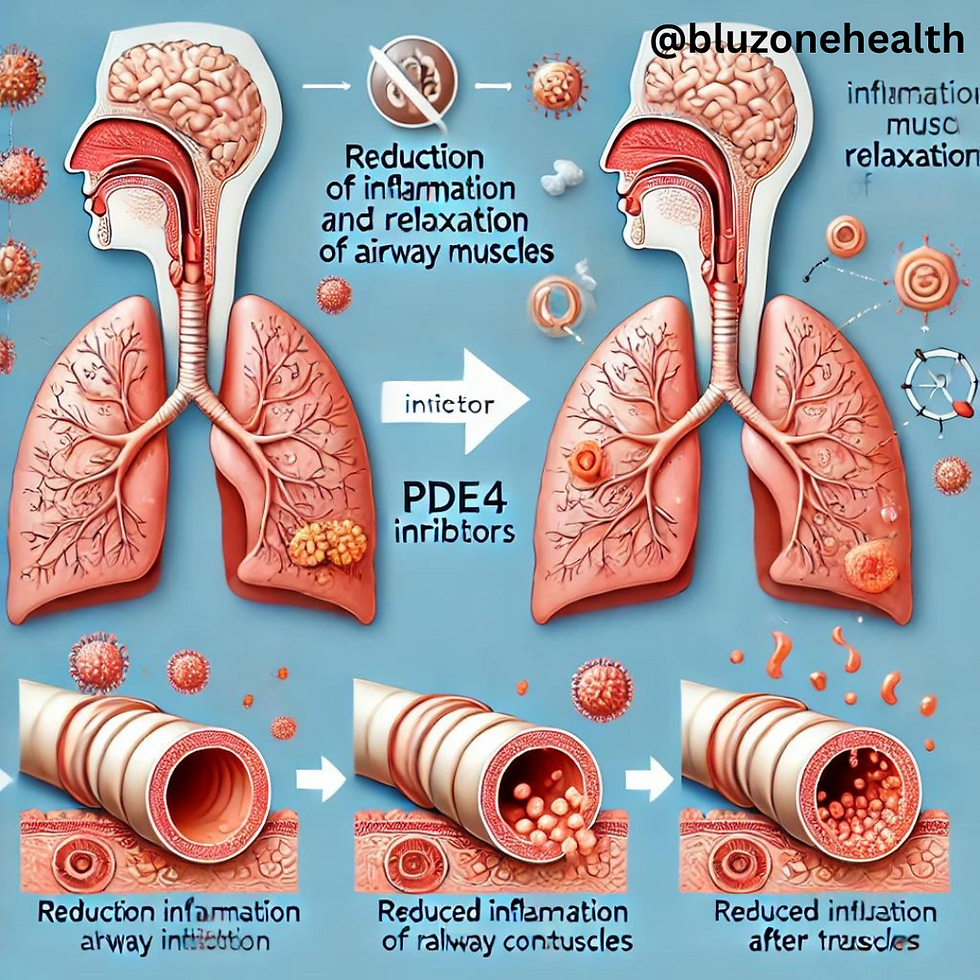Understanding Inhaled PDE4 Inhibitors: A New Hope for COPD Patients
- BluZone Health Team

- Jun 28, 2024
- 4 min read
If you or a loved one has been diagnosed with Chronic Obstructive Pulmonary Disease (COPD), you know how challenging it can be to manage the symptoms. Breathing difficulties, chronic cough, and frequent flare-ups can significantly impact your quality of life. The good news is that a new type of medication, known as inhaled PDE4 inhibitors, is offering fresh hope for those living with COPD. In this article, we'll explore what inhaled PDE4 inhibitors are, how they work, and why they are considered a groundbreaking advancement in COPD treatment.

What is COPD?
Chronic Obstructive Pulmonary Disease (COPD) is a chronic lung disease that makes it hard to breathe. It is usually caused by long-term exposure to irritating gases or particulate matter, most often from cigarette smoke. Over time, COPD leads to inflammation and damage in the lungs, resulting in symptoms like:
Shortness of breath
Chronic cough
Mucus (sputum) production
Wheezing
COPD is a progressive disease, which means it gets worse over time. There is no cure for COPD, but treatments can help manage symptoms and improve quality of life.
Traditional Treatments for COPD
For many years, the primary treatments for COPD have included:
Bronchodilators: These medications help relax the muscles around your airways, making it easier to breathe.
Inhaled Steroids: Steroids reduce inflammation in the airways, helping to control symptoms and prevent flare-ups.
Oxygen Therapy: Some patients need supplemental oxygen to help with breathing.
Lifestyle Changes: Quitting smoking, exercising, and avoiding lung irritants are crucial for managing COPD.
While these treatments can be effective, they often come with side effects. For instance, long-term use of steroids can lead to weight gain, high blood pressure, diabetes, and osteoporosis.
Enter Inhaled PDE4 Inhibitors
Inhaled PDE4 inhibitors represent a new class of medication that offers a promising alternative to traditional treatments, particularly steroids. The first of these drugs, known as ensifentrine (brand name Ohtuvayre), was recently approved by the FDA for the maintenance treatment of COPD.
What are Inhaled PDE4 Inhibitors?
PDE4 inhibitors are drugs that specifically target an enzyme called phosphodiesterase 4 (PDE4). This enzyme is involved in the process of inflammation in the body. By inhibiting PDE4, these medications can reduce inflammation without the need for steroids.
How Do Inhaled PDE4 Inhibitors Work?
To understand how inhaled PDE4 inhibitors work, it helps to know a little bit about the role of inflammation in COPD. Inflammation is a natural response of the immune system to injury or infection. In COPD, however, the lungs are constantly inflamed, which leads to ongoing damage and symptoms.
Inhaled PDE4 inhibitors work by:
Reducing Inflammation: By blocking the PDE4 enzyme, these drugs help to lower the levels of inflammation in the lungs. This can lead to fewer flare-ups and better overall lung function.
Relaxing Airway Muscles: Inhaled PDE4 inhibitors also help to relax the smooth muscles around the airways, making it easier to breathe.
Why Are Inhaled PDE4 Inhibitors Important?
One of the most significant benefits of inhaled PDE4 inhibitors is that they target inflammation directly to the lungs without the side effects associated with steroids. Long-term steroid use can lead to serious health problems, so finding an effective alternative is a major advancement in COPD treatment.
The Benefits of Ensifentrine
Ensifentrine, the first approved inhaled PDE4 inhibitor for COPD, offers several key benefits:
Dual Action: Ensifentrine works as both a bronchodilator and an anti-inflammatory, providing comprehensive relief for COPD symptoms.
Fewer Side Effects: Compared to steroids, ensifentrine has a lower risk of side effects, making it a safer option for long-term use.
Improved Lung Function: Clinical trials have shown that ensifentrine can improve lung function and reduce the frequency of flare-ups.
Clinical Evidence Supporting Inhaled PDE4 Inhibitors
The approval of ensifentrine was based on extensive clinical trials that demonstrated its safety and effectiveness. Studies showed that patients taking ensifentrine experienced:
Improved lung function
Reduced frequency of COPD exacerbations (flare-ups)
Better quality of life
For more detailed information, you can refer to resources like ScienceDirect on PDE4 Inhibitors.
Potential Side Effects of PDE4 Inhibitors
While Inhaled PDE4 inhibitors like ensifentrine are generally well-tolerated, they can still cause some side effects. Common side effects include:
Nausea
Diarrhea
Headache
It's important to talk to your doctor about any side effects you experience, as they can help manage them and adjust your treatment if necessary.
Who Can Benefit from Inhaled PDE4 Inhibitors?
PDE4 inhibitors are typically prescribed for patients with moderate to severe COPD who have not responded well to other treatments. If you are struggling to manage your symptoms with traditional medications, your doctor may consider adding a inhaled PDE4 inhibitor to your treatment plan.
Conclusion: A New Era in COPD Treatment
The introduction of inhaled PDE4 inhibitors like ensifentrine marks a significant advancement in the management of COPD. By targeting inflammation without the side effects of steroids, these medications offer a safer and more effective option for many patients.
If you have COPD, talk to your doctor about whether a inhaled PDE4 inhibitor might be right for you. With new treatments on the horizon, there is hope for better management of this challenging condition.
For further reading and more detailed information, you can check out the following sources:
Remember, managing COPD is a journey, and staying informed about the latest treatments can help you make the best decisions for your health.



Comments